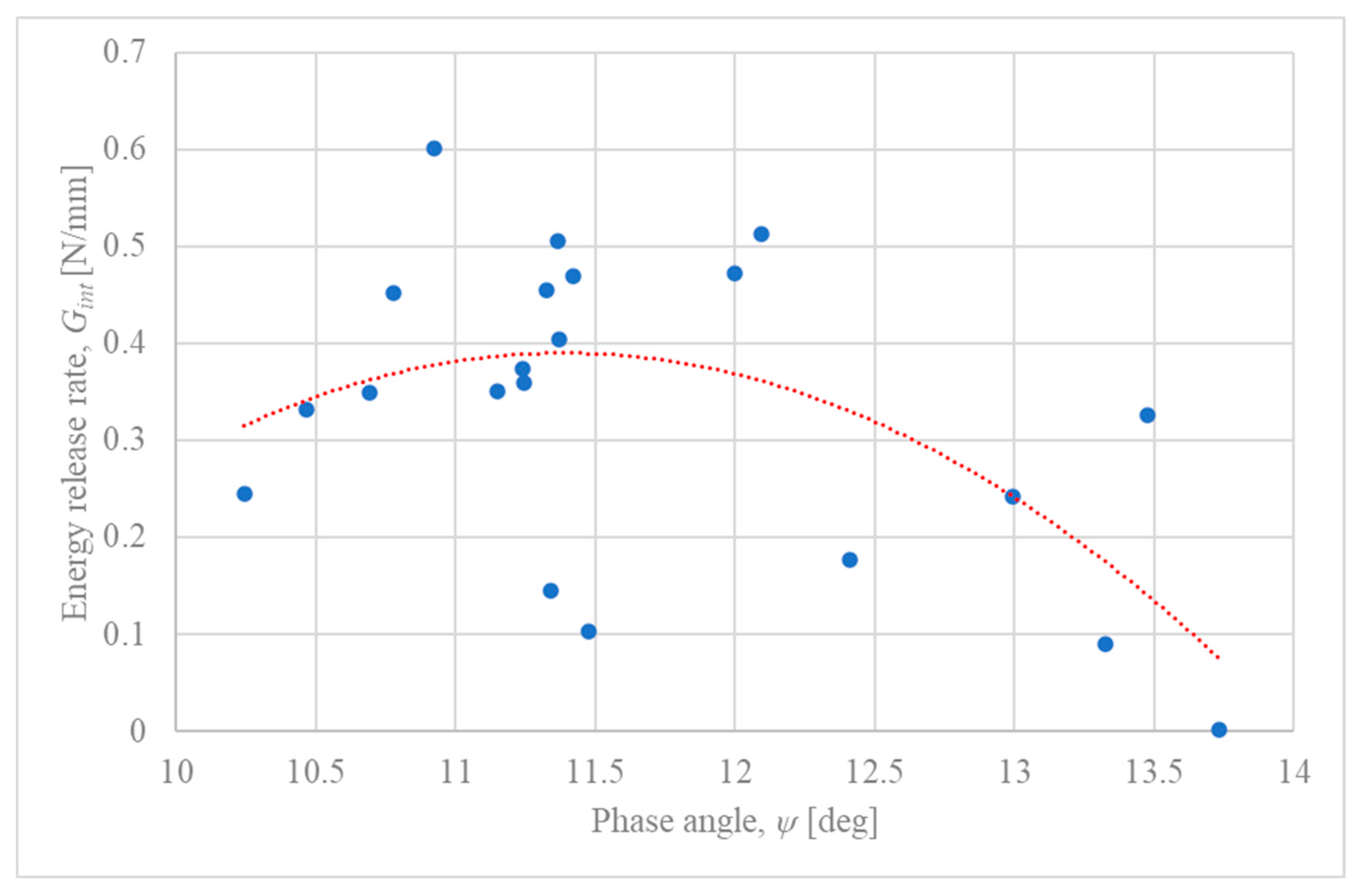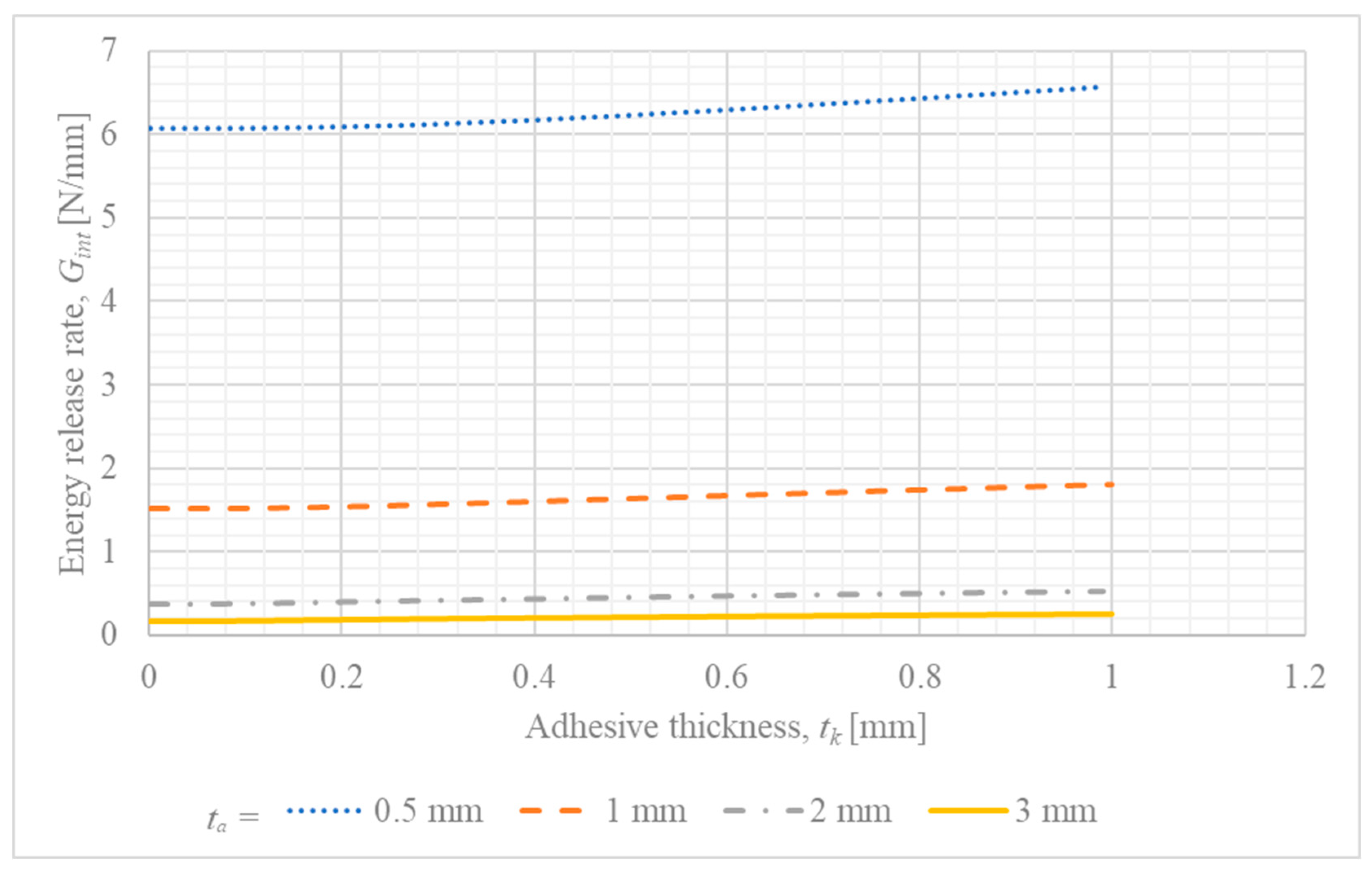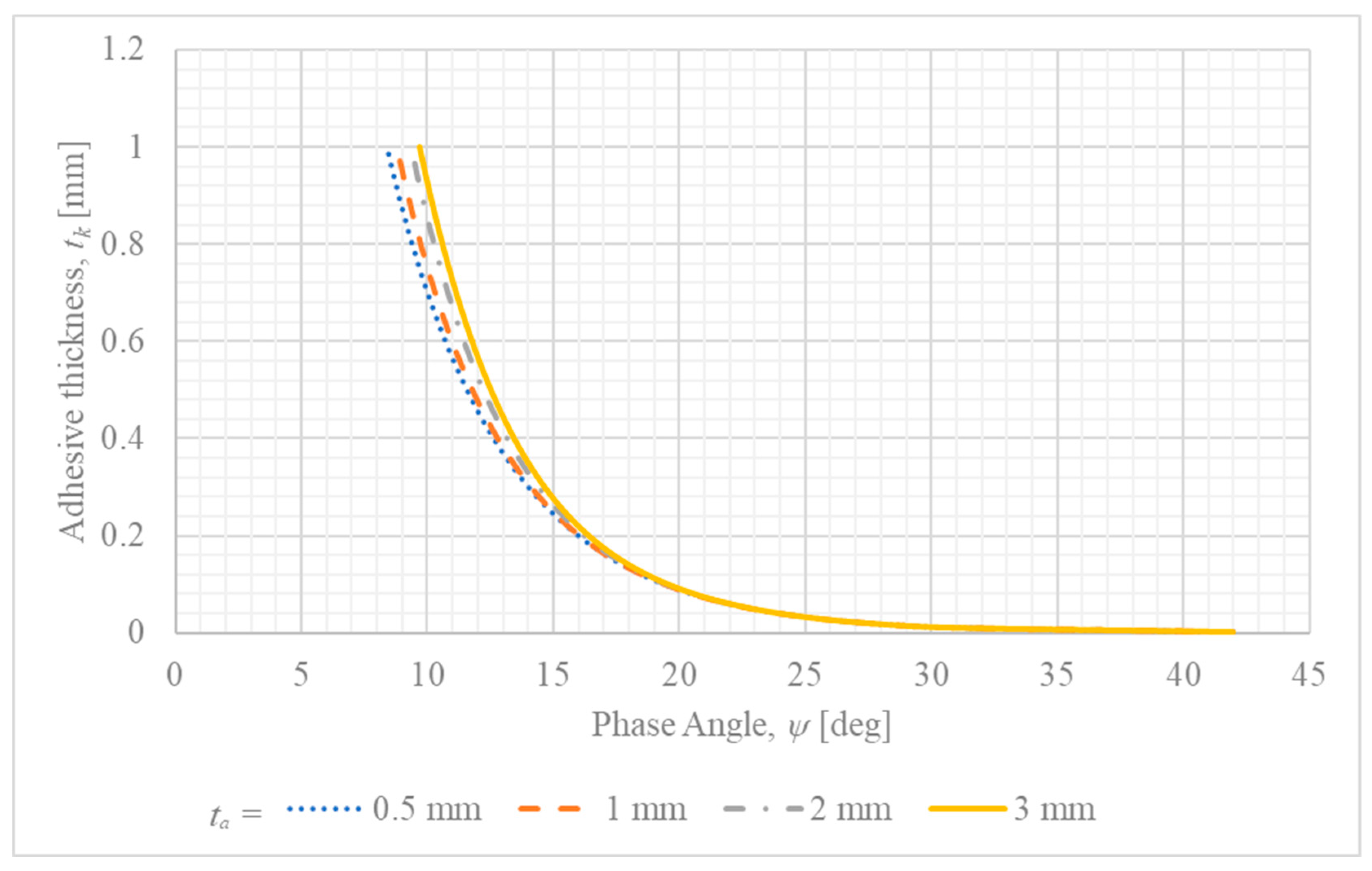Simplified Fracture Mechanics Analysis at the Zinc–Adhesive Interface in Galvanized Steel–CFRP Single-Lap Joints
Abstract
1. Introduction
2. Theoretical Background
2.1. Interface Fracture Mechanics (IFM)–Key Parameters
2.2. Goland–Reissner Model for Single-Lap Joints
2.3. Simplified Shape Functions for Stress Intensity Factors
- : This assumption arises from the fact that, in a homogeneous material, a symmetric tensile load on an edge crack does not induce Mode II.
- : For an edge crack in a homogeneous material subjected to bending, the Mode I shape function depends on [32]. The value of 1.0 is adopted as a further simplification for short cracks.
3. Methodology
3.1. Analyzed Joint Description and Model Idealizations
3.2. Calculation Steps of the Analytical IFM Model
3.3. Parametric Study Plan
3.4. Processing of Experimental Data for Estimation
4. Results
4.1. Estimation of the Interfacial Fracture Toughness Curve Segment, , from Experimental Data
4.2. Influence of Overlap Length () on IFM Parameters
4.3. Influence of Adhesive Layer Thickness () on IFM Parameters
4.4. Influence of Assumed Initial Crack Length () on IFM Parameters
5. Discussion
5.1. Model Simplifications and Limitations
5.2. Analysis of Experimental Fracture Toughness Data
5.3. Effect of Adhesive Thickness on Fracture Mode
5.4. Comparison of Parametric Trends with the Existing Literature
6. Conclusions
- The experimental data, when analyzed with a trendline, suggests a non-linear, parabolic relationship between the interfacial fracture toughness () and the phase angle (). The interface exhibits a peak fracture toughness at a phase angle of approximately , indicating that the joint’s resistance to cracking is highest under a specific mixed-mode condition. The significant scatter around this trend highlights the influence of local microstructural variations and process-induced variability.
- The parametric model demonstrates that for a constant load, increasing the overlap length reduces the crack driving force (), while increasing the adhesive thickness raises it. These trends provide a direct mechanical explanation for experimental observations where longer overlaps increased joint strength and thicker adhesives decreased it, thus validating the model’s qualitative predictive capabilities.
- A key finding, strongly supported by established joint mechanics, is that a thicker adhesive layer shifts the fracture mode from shear-dominated to opening-dominated (a higher phase angle ). This is attributed to the increased joint rotation that amplifies peel stresses at the bond ends.
- The study confirmed the model’s sensitivity to the assumed initial crack length, with being directly proportional to it, which is characteristic of LEFM-based analyses. Furthermore, increasing the thickness of the steel adherend was found to consistently reduce the crack driving force across all analyzed geometric parameters.
- In summary, the simplified analytical model, despite its acknowledged limitations—primarily the use of constant, general-purpose shape functions—effectively captures the qualitative influence of key geometric parameters on the joint’s fracture behavior. It provides a sound mechanical basis for interpreting experimentally observed failure trends and serves as a useful, resource-efficient tool for preliminary research and design explorations.
Author Contributions
Funding
Data Availability Statement
Conflicts of Interest
References
- da Silva, L.F.; Öchsner, A.; Adams, R.D. (Eds.) Handbook of Adhesion Technology, 2nd ed.; Springer: Berlin/Heidelberg, Germany, 2018. [Google Scholar]
- Pocius, A.V. Adhesion and Adhesives Technology: An Introduction, 3rd ed.; Hanser Publications: Cincinnati, OH, USA, 2012. [Google Scholar]
- Dybizbański, M.A.; Rzeszut, K.; Pasternak, H. Experimental investigation on thin-walled steel sigma beams restrained with CFRP textiles. Arch. Civ. Eng. 2025, 17, 159–175. [Google Scholar] [CrossRef]
- Rzeszut, K.; Dybizbański, M.A. Structural behaviour of sigma-type thin-walled cold-formed steel beams reinforced with CFRP textile. Ce/papers 2023, 6, 11–15. [Google Scholar] [CrossRef]
- Hollaway, L.C. A review of the present and future utilisation of FRP composites in the civil infrastructure with reference to their important in-service properties. Constr. Build. Mater. 2010, 24, 2419–2445. [Google Scholar] [CrossRef]
- Zhao, X.L.; Zhang, L. State-of-the-art review on FRP strengthened steel structures. Eng. Struct. 2007, 29, 1808–1823. [Google Scholar] [CrossRef]
- Watkins, E.; Griffiths, C.M.; Richards, C.A.J.; Potts, S.-J.; Batchelor, C.; Barker, P.; Searle, J.; Jewell, E. Improving the corrosion performance of organically coated steel using a sol–gel overcoat. Materials 2024, 17, 1075. [Google Scholar] [CrossRef]
- Porter, F.C. Zinc Handbook: Properties, Processing, and Use in Design; Marcel Dekker: New York, NY, USA, 1991. [Google Scholar]
- Townsend, H.E. Atmospheric corrosion of zinc. In Uhlig’s Corrosion Handbook, 2nd ed.; Revie, R.W., Ed.; John Wiley & Sons: Hoboken, NJ, USA, 2000. [Google Scholar]
- Fürbeth, W.; Stratmann, M. The delamination of polymeric coatings from electrogalvanised steel—A mechanistic approach. Part 1: Delamination from a defect with intact zinc layer. Corros. Sci. 2001, 43, 207–227. [Google Scholar] [CrossRef]
- Fürbeth, W.; Stratmann, M. The delamination of polymeric coatings from electrogalvanized steel—A mechanistic approach. Part 2: Delamination from a defect down to steel. Corros. Sci. 2001, 43, 229–241. [Google Scholar] [CrossRef]
- Fürbeth, W.; Stratmann, M. The delamination of polymeric coatings from electrogalvanized steel—A mechanistic approach. Part 3: Delamination kinetics and influence of CO2. Corros. Sci. 2001, 43, 243–254. [Google Scholar] [CrossRef]
- Cognard, P. (Ed.) Handbook of Adhesives and Sealants: Basic Concepts and High Tech Bonding; Elsevier: Amsterdam, The Netherlands, 2005; Volume 1. [Google Scholar]
- Adams, R.D. (Ed.) Adhesive Bonding: Science, Technology and Applications; Woodhead Publishing: Cambridge, UK, 2005. [Google Scholar]
- Kinloch, A.J. Adhesion and Adhesives: Science and Technology; Chapman and Hall: Boca Raton, FL, USA, 1987. [Google Scholar]
- Rice, J.R. Elastic fracture mechanics concepts for interfacial cracks. J. Appl. Mech. 1988, 55, 98–103. [Google Scholar] [CrossRef]
- Hutchinson, J.W.; Suo, Z. Mixed mode cracking in layered materials. Adv. Appl. Mech. 1992, 29, 63–191. [Google Scholar]
- Banks-Sills, L. Interface fracture mechanics. In Comprehensive Structural Integrity; Milne, I., Ritchie, R.O., Karihaloo, B., Eds.; Elsevier: Amsterdam, The Netherlands, 2003; Volume 2, pp. 285–326. [Google Scholar]
- Anderson, T.L. Fracture Mechanics: Fundamentals and Applications, 4th ed.; CRC Press: Boca Raton, FL, USA, 2017. [Google Scholar]
- Suo, Z. Singularities, interfaces and cracks in dissimilar anisotropic media. Proc. R. Soc. Lond. A Math. Phys. Sci. 1990, 427, 331–358. [Google Scholar]
- Fakhri, M.S.; Al-Mukhtar, A.; Mahmood, I.A. Stress Intensity Factor For Aluminum And Copper Spot Weld Joints. J. Appl. Sci. Eng. 2025, 28, 1411–1423. [Google Scholar]
- Teng, J.G.; Fernando, D.; Yu, T.; Zhao, X.L. Debonding failures in CFRP-strengthened steel structures. Presented at 3rd Asia-Pacific Conference on FRP in Structures, APFIS 2012, Sapporo, Japan, 2–4 February 2012. [Google Scholar]
- Arouche, M.M.; de Freitas, S.T.; de Barros, S. Mixed-mode fracture of composite-to-metal bonded joints. Presented at 5th Brazilian Conference on Composite Materials—BCCM5, São Carlos, Brazil, 18–22 January 2021. [Google Scholar]
- Zeng, J.J.; Gao, W.Y.; Liu, F. Interfacial behavior and debonding failures of full-scale CFRP-strengthened H-section steel beams. Compos. Struct. 2018, 201, 540–552. [Google Scholar] [CrossRef]
- Qiao, Y.; Merkel, D.R.; Nickerson, E.K.; Shin, Y.; Seffens, R.J.; Ortiz, A.; Simmons, K.L. Mode I tensile fracture behavior of adhesively-bonded metal–metal, metal–CFRP, and CFRP–CFRP bi-material combinations analyzed by size effect method. Compos. Part A Appl. Sci. Manuf. 2022, 160, 107025. [Google Scholar] [CrossRef]
- Dybizbański, M.A.; Rzeszut, K.; Abdusattarkhuja, S.; Li, Z. Determination of Strength Parameters of Composite Reinforcement Consisting of Steel Member, Adhesive, and Carbon Fiber Textile. Materials 2024, 17, 6022. [Google Scholar] [CrossRef] [PubMed]
- Williams, M.L. The stresses around a fault or crack in dissimilar media. Bull. Seismol. Soc. Am. 1959, 49, 199–204. [Google Scholar] [CrossRef]
- Perera, D.Y. On adhesion and stress in organic coatings. Prog. Org. Coat. 1996, 28, 21–23. [Google Scholar]
- Dundurs, J. Discussion: “Edge-Bonded Dissimilar Orthogonal Elastic Wedges Under Normal and Shear Loading”. J. Appl. Mech. 1969, 36, 650–652. [Google Scholar] [CrossRef]
- Bahrami, B.; Nejati, M.; Ayatollahi, M.R.; Driesner, T. Theory and experiment on true mode II fracturing of rocks. Eng. Fract. Mech. 2020, 240, 107314. [Google Scholar] [CrossRef]
- Goland, M.; Reissner, E. The stresses in cemented joints. J. Appl. Mech. 1944, 11, A17–A27. [Google Scholar] [CrossRef]
- Tada, H.; Paris, P.C.; Irwin, G.R. The Stress Analysis of Cracks Handbook, 3rd ed.; ASME Press: New York, NY, USA, 2000. [Google Scholar]
- Murakami, Y. (Ed.) Stress Intensity Factors Handbook; Pergamon Press: Oxford, UK, 1987; Volumes 1–2. [Google Scholar]
- Xu, J.Q.; Yuuki, R. Stress intensity factors for interface crack between dissimilar orthotropic materials. the case where principal axes are not aligned with the interface. Trans. Jpn. Soc. Mech. Eng. Ser. A 1994, 60, 1943–1950. [Google Scholar] [CrossRef][Green Version]
- Kania, H.; Sipa, J. Microstructure characterization and corrosion resistance of zinc coating obtained on high-strength grade 10.9 bolts using a new thermal diffusion process. Materials 2019, 12, 1400. [Google Scholar] [CrossRef] [PubMed]
- Parisot, R.; Forest, S.; Pineau, A.; Grillon, F.; Demonet, X.; Mataigne, J.-M. Deformation and damage mechanisms of zinc coatings on hot-dip galvanized steel sheets: Part I. Deformation modes. Metall. Mater. Trans. A 2004, 35, 797–811. [Google Scholar] [CrossRef]
- Parisot, R.; Forest, S.; Pineau, A.; Grillon, F.; Demonet, X.; Mataigne, J.-M. Deformation and damage mechanisms of zinc coatings on hot-dip galvanized steel sheets: Part II. damage modes. Metall. Mater. Trans. A 2004, 35, 813–823. [Google Scholar] [CrossRef]
- Vincent, G.; Bonasso, N.; Lecomte, J.S.; Colinet, B.; Gay, B.; Esling, C. The relationship between the fracture toughness and grain boundary characteristics in hot-dip galvanized zinc coatings. J. Mater. Sci. 2006, 41, 5966–5975. [Google Scholar] [CrossRef]
- De Munck, J.; Van Landuyt, K.; Peumans, M.; Poitevin, A.; Lambrechts, P.; Braem, M.; Van Meerbeek, B. A critical review of the durability of adhesion to tooth tissue: Methods results. J. Dent. Res. 2005, 84, 118–132. [Google Scholar] [CrossRef]
- Tomblin, J.S.; Seneviratne, W.; Oleksuk, K. Investigation of Thick Bondline Adhesive Joints (No. DOT/FAA/AR-01/33); Office of Aviation Research: Washington, DC, USA, 2001; p. 20591. [Google Scholar]
- Hart-Smith, L. Designing to minimize peel stresses in adhesive-bonded joints. In Delamination and Debonding of Materials; ASTM International: West Conshohocken, PA, USA, 1985; pp. 238–266. [Google Scholar]
- Grant, L.D.R.; Adams, R.D.; da Silva, L.F.M. Experimental and numerical analysis of single-lap joints for the automotive industry. Int. J. Adhes. Adhes. 2009, 29, 405–413. [Google Scholar] [CrossRef]
- Banea, M.D.; da Silva, L.F.; Campilho, R.D. The effect of adhesive thickness on the mechanical behavior of a structural polyurethane adhesive. J. Adhes. 2014, 91, 331–346. [Google Scholar] [CrossRef]
- Lee, D.B.; Ikeda, T.; Miyazaki, N.; Choi, N.S. Effect of bond thickness on the fracture toughness of adhesive joints. J. Eng. Mater. Technol. 2004, 126, 14–18. [Google Scholar] [CrossRef]
- Monteiro, J.; Salgado, R.; Rocha, T.; Pereira, G.; Marques, E.; Carbas, R.; da Silva, L.F.M. Effect of adhesive type and overlap length on the mechanical resistance of a simple overlap adhesive joint. U. Porto J. Eng. 2021, 7, 1–12. [Google Scholar] [CrossRef]







Disclaimer/Publisher’s Note: The statements, opinions and data contained in all publications are solely those of the individual author(s) and contributor(s) and not of MDPI and/or the editor(s). MDPI and/or the editor(s) disclaim responsibility for any injury to people or property resulting from any ideas, methods, instructions or products referred to in the content. |
© 2025 by the authors. Licensee MDPI, Basel, Switzerland. This article is an open access article distributed under the terms and conditions of the Creative Commons Attribution (CC BY) license (https://creativecommons.org/licenses/by/4.0/).
Share and Cite
Dybizbański, M.A.; Rzeszut, K. Simplified Fracture Mechanics Analysis at the Zinc–Adhesive Interface in Galvanized Steel–CFRP Single-Lap Joints. Materials 2025, 18, 5038. https://doi.org/10.3390/ma18215038
Dybizbański MA, Rzeszut K. Simplified Fracture Mechanics Analysis at the Zinc–Adhesive Interface in Galvanized Steel–CFRP Single-Lap Joints. Materials. 2025; 18(21):5038. https://doi.org/10.3390/ma18215038
Chicago/Turabian StyleDybizbański, Maciej Adam, and Katarzyna Rzeszut. 2025. "Simplified Fracture Mechanics Analysis at the Zinc–Adhesive Interface in Galvanized Steel–CFRP Single-Lap Joints" Materials 18, no. 21: 5038. https://doi.org/10.3390/ma18215038
APA StyleDybizbański, M. A., & Rzeszut, K. (2025). Simplified Fracture Mechanics Analysis at the Zinc–Adhesive Interface in Galvanized Steel–CFRP Single-Lap Joints. Materials, 18(21), 5038. https://doi.org/10.3390/ma18215038







